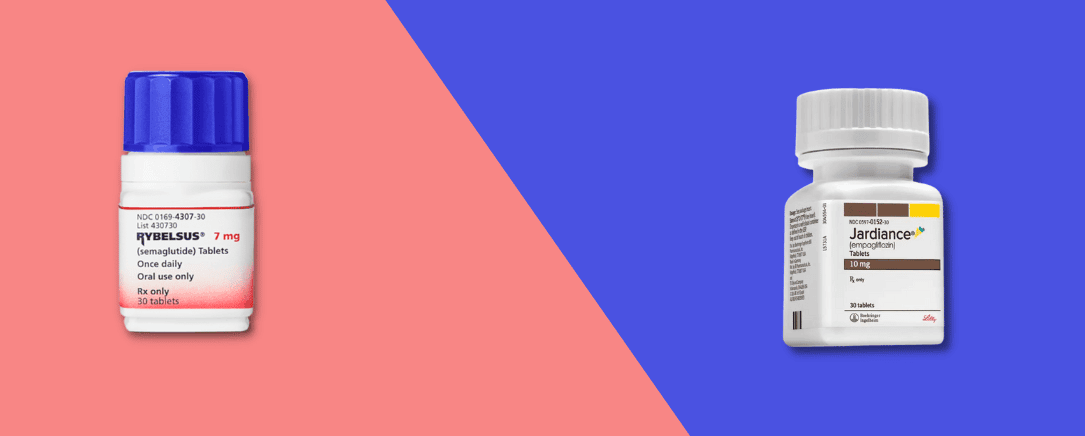Jardiance vs Rybelsus
Today, treating type 2 diabetes is made easier with the use of oral medications. Examples of these medications include the most-used – Rybelsus and Jardiance.
What are the differences between these two effective treatments? In this article, we will be tackling about Rybelsus vs Jardiance. You will learn the uses and functions of these anti-diabetes agents, their precautions or warnings, dosages, market prices, and side effects. Read on and learn more.
Uses
Also known by its generic name semaglutide, Rybelsus is a prescription medicine used to treat adults with type 2 diabetes. This medicine works by lowering blood glucose levels by increasing the release of insulin and decreasing the secretion of glucagon.
Rybelsus is prescribed in adults alongside proper exercise and a balanced diet. It also belongs to a group of drugs called GLP-1 receptor agonists. The active ingredient in Rybelsus (semaglutide) stimulates the mentioned receptors and enables the beta cells in the pancreas to produce more insulin. This process lowers blood sugar after every meal.
On the other hand, Jardiance is also an oral diabetes medicine prescribed in adults with type 2 diabetes. It works by controlling blood sugar levels and preventing a surge or diabetes attacks. It is available under the generic name empagliflozin, which is also known as the primary ingredient of Jardiance.
Jardiance belongs to a group of drugs called SGLT-2 inhibitors (sodium-glucose cotransporter-2 inhibitors). These inhibitors function by lowering high blood glucose levels in people diagnosed with type 2 diabetes. They are also called gliflozins. It is also essential to note that Jardiance is prescribed alongside the correct diet and proper exercise.
In summary, when considering options like Rybelsus and Jardiance together, it’s essential to understand how combining treatments might affect your health, including the availability of Rybelsus generic alternatives.
Precautions and Warnings
Follow these directives before taking any of the mentioned medicines:
Rybelsus:
- Do not take Rybelsus if you are allergic to it, especially to its ingredient, semaglutide. This medicine is only prescribed to adults. Any person under the age of 18 is not allowed to take Rybelsus.
- To ensure that Rybelsus is safe to use, tell your healthcare professional if you have a history of the following conditions:
- Problems with your pancreas
- Kidney disease
- Eye disease (cataracts or glaucoma)
- Intestinal disorder
Jardiance:
- Avoid consuming Jardiance if you have a known allergy to it, especially to empagliflozin. Note that this medicine is not available for people with type 1 diabetes. If you are under 18 years, Jardiance is not for your prescription.
- To ensure that Jardiance is safe to consume, inform your healthcare professional if you have a history of the following medical dilemmas:
- Liver disease
- Kidney problems
- Pancreatitis
- Genital infection
- Alcoholism
Dosage
The recommended doses for Rybelsus are as follows:
- Take 3 mg of Rybelsus orally once per day for 30 days.
- If maintenance dosage is necessary, you will take 7 to 14 mg of Rybelsus per day.
The recommended doses for Jardiance include the following:
- Take 10 mg of Jardiance once a day. Follow this process every morning.
- For the maximum dosage, take 25 mg per day.
Side Effects
Common side effects of Rybelsus:
- Low blood sugar
- Upset stomach
- Heartburn
- Nausea
- Vomiting
- Diarrhea
- Dizziness
- Tiredness
- Lightheadedness
- Sweating
Common side effects of Jardiance:
- A bladder infection
- Yeast infection in women
- Dehydration
- Dizziness
- Lightheadedness
- Trouble breathing
- Nausea
- Vomiting
- Stomach pain
- Drowsiness
Note: Keep in mind that these side effects only stay a short while. However, if these reactions persist, contact your healthcare professional immediately and obtain medical care.
Doctor’s Recommendation
When initiating Rybelsus, begin with a 3mg dosage for the first 30 days. During this period, it’s important to keep a daily record of blood sugar levels in a journal. If the blood sugar remains elevated, consider increasing the dosage to 7mg and subsequently to 14mg as needed.
For those newly diagnosed with diabetes, the recommended treatment approach starts with a GLP-1 agonist, followed by the highest tolerable dose of Metformin, and then SGLT2 inhibitors. However, for individuals with Type 2 diabetes who also have heart failure, Metformin may be omitted entirely. In such cases, treatment should focus on a combination of a GLP-1 agonist and an SGLT2 inhibitor.



